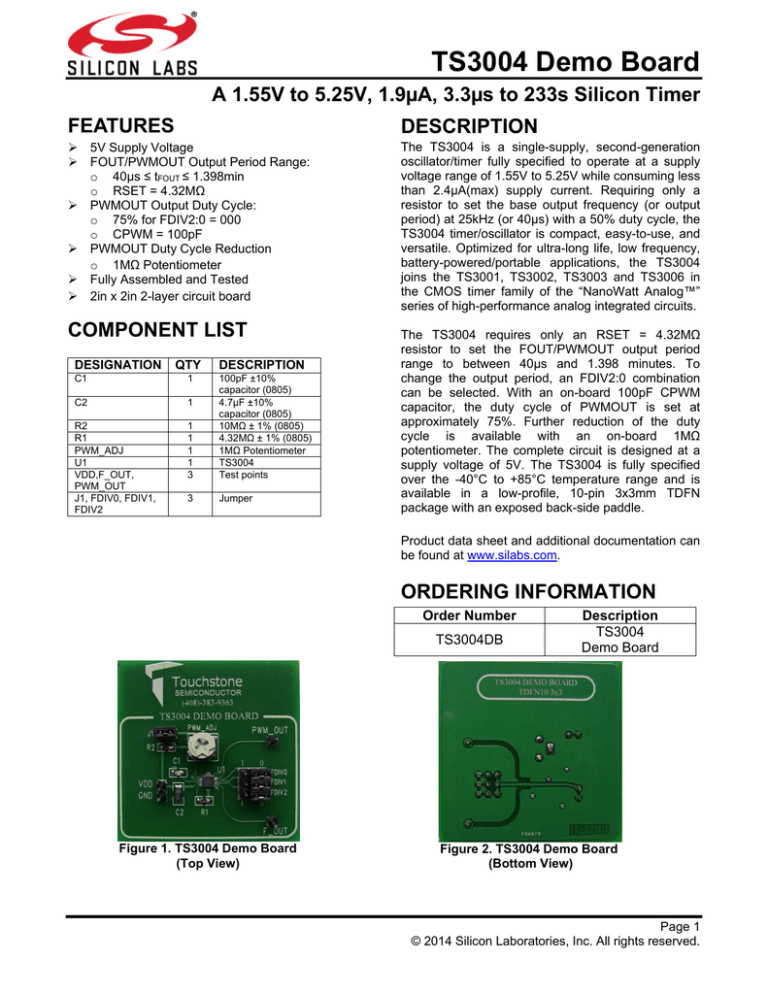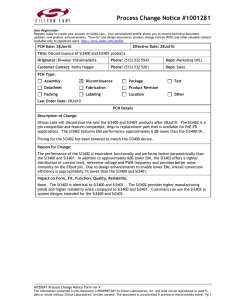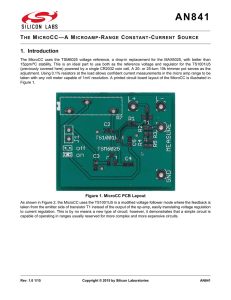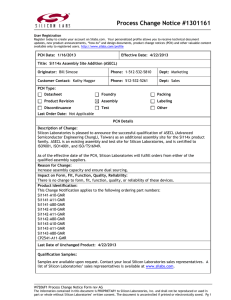
TS3004 Demo Board
A 1.55V to 5.25V, 1.9µA, 3.3µs to 233s Silicon Timer
FEATURES
DESCRIPTION
The TS3004 is a single-supply, second-generation
oscillator/timer fully specified to operate at a supply
voltage range of 1.55V to 5.25V while consuming less
than 2.4μA(max) supply current. Requiring only a
resistor to set the base output frequency (or output
period) at 25kHz (or 40µs) with a 50% duty cycle, the
TS3004 timer/oscillator is compact, easy-to-use, and
versatile. Optimized for ultra-long life, low frequency,
battery-powered/portable applications, the TS3004
joins the TS3001, TS3002, TS3003 and TS3006 in
the CMOS timer family of the “NanoWatt Analog™”
series of high-performance analog integrated circuits.
5V Supply Voltage
FOUT/PWMOUT Output Period Range:
o 40µs ≤ tFOUT ≤ 1.398min
o RSET = 4.32MΩ
PWMOUT Output Duty Cycle:
o 75% for FDIV2:0 = 000
o CPWM = 100pF
PWMOUT Duty Cycle Reduction
o 1MΩ Potentiometer
Fully Assembled and Tested
2in x 2in 2-layer circuit board
COMPONENT LIST
DESIGNATION
QTY
DESCRIPTION
C1
1
C2
1
R2
R1
PWM_ADJ
U1
VDD,F_OUT,
PWM_OUT
J1, FDIV0, FDIV1,
FDIV2
1
1
1
1
3
100pF ±10%
capacitor (0805)
4.7µF ±10%
capacitor (0805)
10MΩ ± 1% (0805)
4.32MΩ ± 1% (0805)
1MΩ Potentiometer
TS3004
Test points
3
Jumper
The TS3004 requires only an RSET = 4.32MΩ
resistor to set the FOUT/PWMOUT output period
range to between 40µs and 1.398 minutes. To
change the output period, an FDIV2:0 combination
can be selected. With an on-board 100pF CPWM
capacitor, the duty cycle of PWMOUT is set at
approximately 75%. Further reduction of the duty
cycle is available with an on-board 1MΩ
potentiometer. The complete circuit is designed at a
supply voltage of 5V. The TS3004 is fully specified
over the -40°C to +85°C temperature range and is
available in a low-profile, 10-pin 3x3mm TDFN
package with an exposed back-side paddle.
Product data sheet and additional documentation can
be found at www.silabs.com.
ORDERING INFORMATION
Order Number
TS3004DB
Figure 1. TS3004 Demo Board
(Top View)
Description
TS3004
Demo Board
Figure 2. TS3004 Demo Board
(Bottom View)
Page 1
© 2014 Silicon Laboratories, Inc. All rights reserved.
TS3004 Demo Board
DESCRIPTION
The TS3004 requires only an RSET = 4.32MΩ
resistor to set the FOUT/PWMOUT output period
between 40µs and 1.398 minutes. To change the
output period, an FDIV2:0 combination can be
selected. With an on-board 100pF CPWM capacitor,
the duty cycle of PWMOUT is set at approximately
75%. Further reduction of the duty cycle is available
with an on-board 1MΩ potentiometer. The complete
circuit is designed at a supply voltage of 5V and it is
shown in Figure 1.
where ICPWM and VCPWM is the current supplied and
voltage applied to the CPWM capacitor, respectively.
The pulse width is determined based on the period of
FOUT and should never be greater than the period at
FOUT. Make sure the PWM_CNTRL pin is set to at
least 400mV when calculating the pulse width of
PWMOUT. Note VCPWM is approximately 300mV,
which is the RSET voltage. Also note that ICPWM is
either 1µA or 100nA. Refer to Table 2 for the output
period range available with a 10MΩ RSET resistor.
ICPWM
FDIV
tFOUT
(A)
2:0
000
40µs
1µ
001
320µs
1µ
010
2560µs
100n
011
20.48ms
100n
100
163.84ms 100n
101
1.310s
100n
110
10.486s
100n
111
1.398min 100n
Table 2: FOUT and PWMOUT Frequency
Range per FDIV2:0 Combination
for RSET= 4.32MΩ
The TS3004 is a user-programmable oscillator where
the period of the square wave at its FOUT terminal is
generated by an external resistor connected to the
RSET pin. The output period is given by:
tFOUT (s) =
8FDIV2:0 x 4.32MΩ
1.08E11
Equation 1. FOUT Frequency Calculation where
FDIV2:0 = 0 to 7
With RSET = 4.32MΩ and FDIV2:0=000(0), the FOUT
period is approximately 40µs with a 50% duty cycle.
As design aids, Tables 1 lists TS3004’s typical FOUT
period for various standard values for RSET and
FDIV2:0 = 111(7).
RSET (MΩ)
tFOUT(s)
0.360
6.99
1
19.42
2.49
48.35
4.32
83.89
6.81
132.27
9.76
189.39
12
233
Table 1: tFOUT vs RSET for FDIV2:0 = 111(7)
The TS3004 also provides a separate PWM output
signal at its PWMOUT terminal that is anti-phase with
respect to FOUT. To adjust the pulse width of the
PWMOUT output, a single capacitor can be placed at
the CPWM pin. To determine the capacitance needed
for a desired pulse width, the following equation is to
be used:
Pulse Width(s) x ICPWM
CPWM(F)=
VCPWM ≅300mV
The PWMOUT output pulse width can be adjusted
further after selecting a CPWM capacitor. This can be
achieved by applying a voltage to the PWM_CNTRL
pin between VRSET and GND. With a voltage of at
least VRSET, the pulse width is set based on
Equation 2. For example, with a period of 40µs and a
0.1µF capacitor at the CPWM pin generates a pulse
width of approximately 30ms. This can be calculated
using Equation 2. By reducing the PWM_CNTRL
voltage from VRSET ≅ 300mV to GND, the pulse width
can be reduced further. Note that VRSET can be set up
to VDD.
QUICK START PROCEDURE
Required Equipment
TS3004 Demo Board
DC Power Supply
Oscilloscope
equivalent
Two 10X, 15pF//10MΩ oscilloscope probes
Potentiometer screwdriver
Model
Agilent
DSO1014A
or
Equation 2. CPWM Capacitor Calculation
TS3004-EVB Rev. 1.0
Page 2
TS3004 Demo Board
To evaluate the TS3004 silicon timer, the following
steps are to be performed:
1) Before connecting the DC power supply to the
demo board, turn on the power supply, set the
DC voltage to 5V, and then turn it off.
2) Connect the DC power supply positive terminal to
the test point labeled VDD. Connect the negative
terminal of the DC power supply to the test point
labeled GND.
3) To monitor the FOUT output signal, connect the
signal terminal of an oscilloscope probe to the
test point labeled FOUT and the ground terminal
to the test point labeled GND.
4) To monitor the PWMOUT output signal, connect
the signal terminal of a second oscilloscope
probe to the test point labeled PWM_OUT and
the ground terminal to the test point labeled GND.
5)
Select two channels on the oscilloscope and set
the vertical voltage scale and the vertical position
on each channel to 2V/DIV and 0V, respectively.
Set the horizontal time scale to 5µs/DIV. The
coupling should be DC coupling. Turn on the
power supply.
The supply current will vary depending on the
load on the output. Given the default set-up on
the board, the FOUT/PWMOUT output period is
approximately 40µs. The PWMOUT duty cycle is
set to approximately 75%. With an output load of
15pF on both FOUT and PWMOUT outputs due
to the oscilloscope probes, the supply current
should be less than 8µA.
6) To change the period, change the combination of
FDIV2:0 via jumpers FDIV2, FDIV1, and FDIV0.
Refer to Table 2.
7) If further reduction of the duty cycle of the
PWMOUT output is desired, turn the
potentiometer clockwise. If jumper J1 is removed,
the PWM_CNTRL pin is tied to VDD and the
potentiometer will not change the PWMOUT
output duty cycle.
Figure 3. TS3004 Demo Board Circuit
TS3004-EVB Rev. 1.0
Page 3
TS3004 Demo Board
Period vs RSET
120
PERIOD - µs
100
80
60
40
20
0
0
2
4
6
8
10
12
RSET - MΩ
Figure 4. FOUT/PWMOUT Period vs RSET
Figure 5. Top Layer View #1
Figure 6. Top Layer View #2
Figure 7. Bottom Layer (GND) #2
Figure 8. Bottom Layer (GND) #2
Page 4 Silicon Laboratories, Inc.
400 West Cesar Chavez, Austin, TX 78701
+1 (512) 416-8500 ▪ www.silabs.com
TS3004-EVB Rev. 1.0
Smart.
Connected.
Energy-Friendly
Products
Quality
Support and Community
www.silabs.com/products
www.silabs.com/quality
community.silabs.com
Disclaimer
Silicon Laboratories intends to provide customers with the latest, accurate, and in-depth documentation of all peripherals and modules available for system and software implementers
using or intending to use the Silicon Laboratories products. Characterization data, available modules and peripherals, memory sizes and memory addresses refer to each specific
device, and "Typical" parameters provided can and do vary in different applications. Application examples described herein are for illustrative purposes only. Silicon Laboratories
reserves the right to make changes without further notice and limitation to product information, specifications, and descriptions herein, and does not give warranties as to the accuracy
or completeness of the included information. Silicon Laboratories shall have no liability for the consequences of use of the information supplied herein. This document does not imply
or express copyright licenses granted hereunder to design or fabricate any integrated circuits. The products must not be used within any Life Support System without the specific
written consent of Silicon Laboratories. A "Life Support System" is any product or system intended to support or sustain life and/or health, which, if it fails, can be reasonably expected
to result in significant personal injury or death. Silicon Laboratories products are generally not intended for military applications. Silicon Laboratories products shall under no
circumstances be used in weapons of mass destruction including (but not limited to) nuclear, biological or chemical weapons, or missiles capable of delivering such weapons.
Trademark Information
Silicon Laboratories Inc., Silicon Laboratories, Silicon Labs, SiLabs and the Silicon Labs logo, CMEMS®, EFM, EFM32, EFR, Energy Micro, Energy Micro logo and combinations
thereof, "the world’s most energy friendly microcontrollers", Ember®, EZLink®, EZMac®, EZRadio®, EZRadioPRO®, DSPLL®, ISOmodem ®, Precision32®, ProSLIC®, SiPHY®,
USBXpress® and others are trademarks or registered trademarks of Silicon Laboratories Inc. ARM, CORTEX, Cortex-M3 and THUMB are trademarks or registered trademarks of
ARM Holdings. Keil is a registered trademark of ARM Limited. All other products or brand names mentioned herein are trademarks of their respective holders.
Silicon Laboratories Inc.
400 West Cesar Chavez
Austin, TX 78701
USA
http://www.silabs.com




